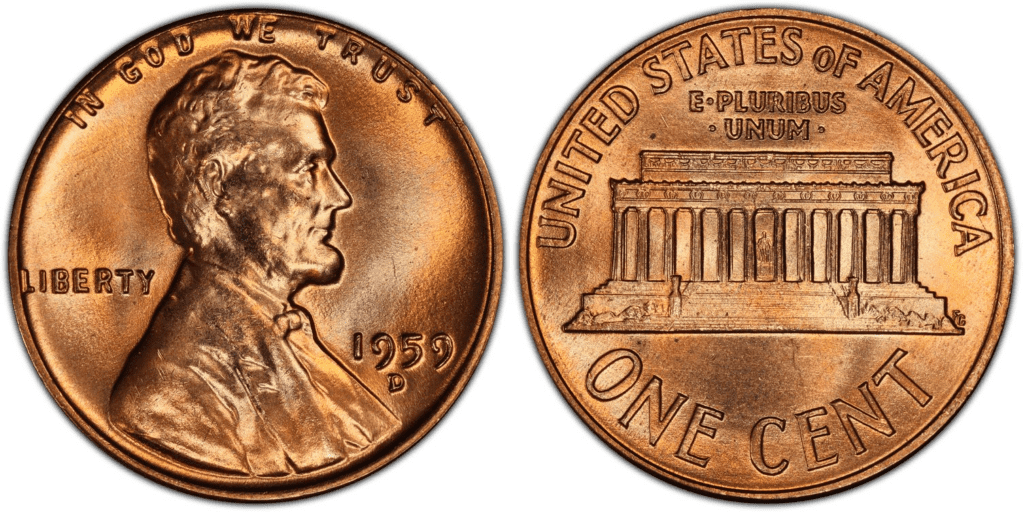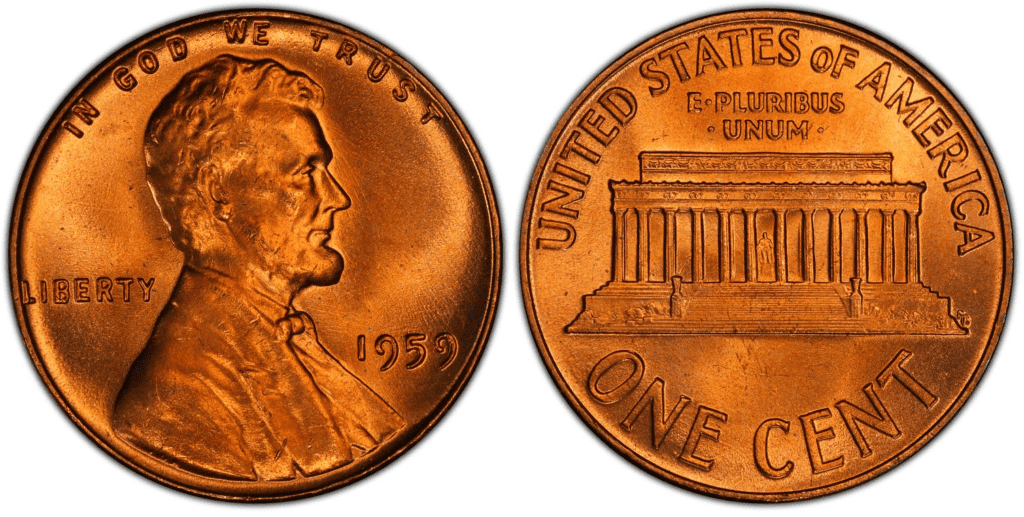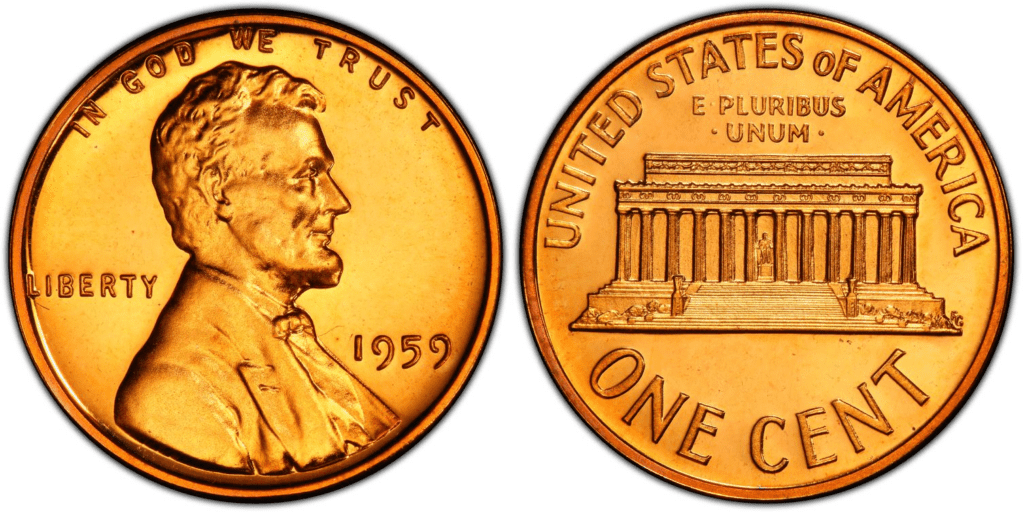What Is the 1959 Lincoln Penny Made Of?
The 1959 Lincoln penny is made of 95% copper and 5% tin and zinc. It has a plain edge, a weight of 3.11 grams, and a diameter of 19 millimeters.
Victor David Brenner designed the 1959 Lincoln penny for the obverse and Frank Gasparro for the reverse.

The obverse features the image of Abraham Lincoln, the 16th president of the United States. On top of his head, you’ll read, “IN GOD WE TRUST.” On the left is written “LIBERTY,” and on the right is the year of minting, which is 1959.
On the reverse, you’ll find the Lincoln Memorial. On top of the coin arches the inscription, UNITED STATES OF AMERICA. You’ll also find the US motto, “E PLURIBUS UNUM,” which means out of many, one. Next, you’ll find the words “ONE CENT” arching below the coin.
The Lincoln cent or penny was first struck in 1909 by the US Mint. At that time, the reverse wasn’t the Lincoln Memorial yet. Instead, the reverse features two stalks of wheat. That explains why way back at that time, the Lincoln penny was referred to as “wheat pennies.” It was only by 1959 that Frank Gasparro’s design was added to the Lincoln Memorial.
Even before the official release of the Lincoln penny, there were already 20,000,000 Lincoln pennies that the Philadelphia Mint struck. There was great anticipation and public interest in the new penny in 1909. One reason is that the US Mint didn’t allow newspapers to show the public what the coin would look like. This has caused great curiosity.
Thus, on the morning of August 2, 1909, many people lined up to the nearest Treasury facilities in their area. Some people received the desired number of pennies they liked, but soon, the Treasury needed to ration the coin.
The Lincoln penny was the first widely circulated US coin with a face of a president.
1959 Lincoln Penny Varieties
The 1959 Lincoln penny comes in different varieties. These are the 1959-P, 1959-D, and 1959-P proofs. Some error coins sporadically appeared during the minting process.
Here are the 1959 Lincoln penny varieties that you should know:
1959 D Lincoln Penny
Year of minting: 1959
Mint Mark: D
Place of minting: Denver
Quantity produced: 1,279,760,000
Face Value: $0.01 (one cent)
Price: $0.01 to $15.00 (or more)
Mass: 3.11 grams
Edge: Plain
Designer: Victor D. Brenner (obverse) / Frank Gasparro (reverse)
Composition: 95% copper and 5% tin and zinc
Diameter: 19.05 mm
Thickness: 1.52 mm

photo source: PCGS
The Denver Mint produced more than 1.27 billion 1959 D pennies. The penny is the smallest coin denomination in the United States. Thus, it is unsurprising that it has a very high number of mintage. The price range of the 1959 D penny is $0.01 to $15.00.
According to PCGS, the 1959-D penny is difficult to find in a grade of MS67 or higher. According to current estimates, only about 50 1959-D coins survived and received an MS67 grade today.
1959 P Lincoln Penny
Year of minting: 1959
Mint Mark: None
Place of minting: Philadelphia
Quantity produced: 609,715,000
Face Value: $0.01 (one cent)
Price: $0.01 to $14.00 (or more)
Mass: 3.11 grams
Edge: Plain
Designer: Victor D. Brenner (obverse) / Frank Gasparro (reverse)
Composition: 95% copper and 5% tin and zinc
Diameter: 19.05 mm
Thickness: 1.52 mm

photo source: PCGS
The Philadelphia Mint produced more than 609 million Lincoln pennies in 1959. Compared to the Denver Mint, the Philadelphia Mint penny production was lower. The price range is 0.01 to $14.00. Some 1959 P pennies could be worth more than that in the open market.
1959 Lincoln Penny (Proof)
Year of minting: 1959
Mint Mark: None
Place of minting: Philadelphia
Quantity produced: 1,149,291
Face Value: $0.01 (one cent)
Price: $0.01 to $31.00 (or more)
Mass: 3.11 grams
Edge: Plain
Designer: Victor D. Brenner (obverse) / Frank Gasparro (reverse)
Composition: 95% copper and 5% tin and zinc
Diameter: 19.05 mm
Thickness: 1.52 mm

photo source: PCGS
Aside from producing regular strike pennies, the Philadelphia Mint in 1959 produced proof coins, too. However, since proof coins are not for the general public, there were only about one million 1959 proof pennies.
As mentioned above, 1959 was the first year for the penny to have the Lincoln Memorial as its reverse. Most proof coins from this series can easily receive a grade of PR63 to PR 65. However, only a few surviving coins received PR67. Aside from that, PR69-graded 1959-proof pennies are super scarce.
If you have this type of coin, you could be looking at a coin with thousands of dollars as its price tag.
List of 1959 Lincoln Penny Errors
With more than 1.89 billion 1959 Lincoln pennies, there’s a huge chance that error coins would appear. There are different reasons for the 1959 pennies to receive an error. It can be caused by human intervention or machine failure.
Here’s a good example of a 1959 Lincoln penny error:
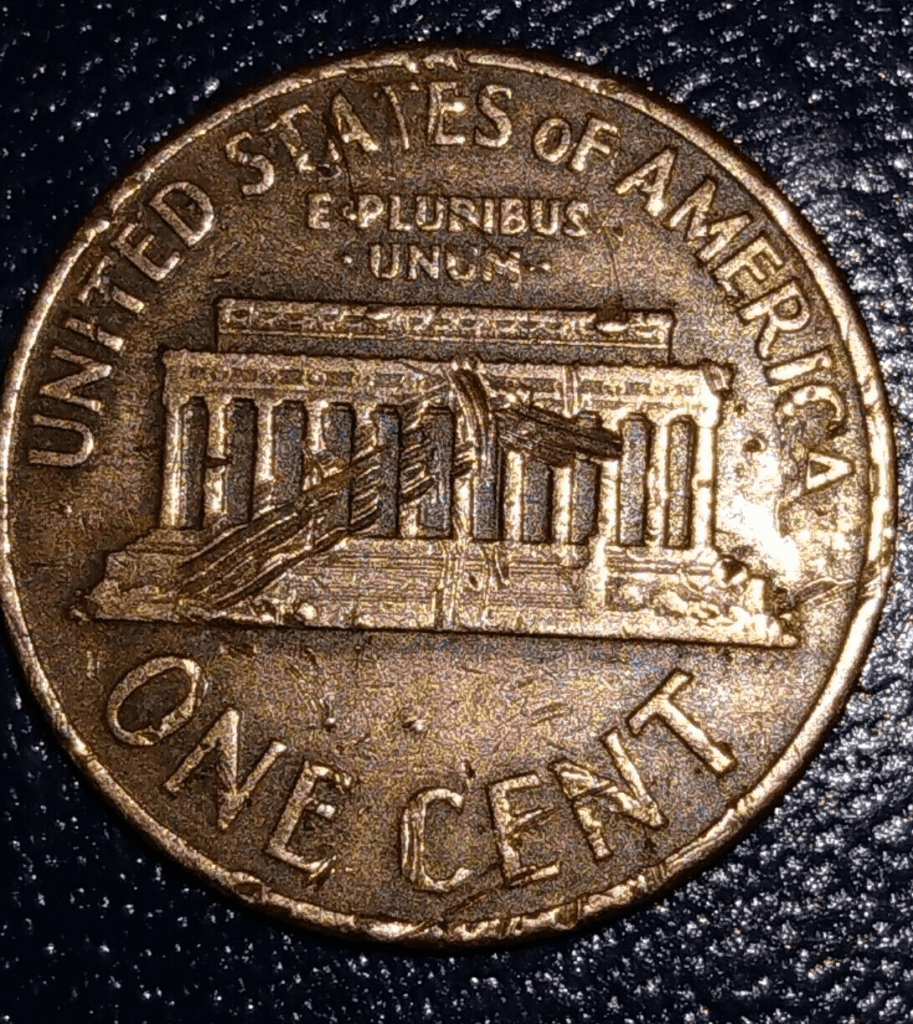
You can see multiple errors here. The most obvious are the lines found in the center. This can be caused by possibly a broken die or rotated die. The letters in the word “STATES” are deformed. The designer’s initials are missing, and other errors are present.
The Denver Mint is known to add its mint mark to the penny. Sometimes, the mint mark is struck twice, causing a deformity or doubling. This error is what you call the repunched mint or RPM error.
Here’s an example:

The die and planchet may experience misalignment. Thus, when the die strikes the planchet, it is off-center. Here’s an example of an off-center error:
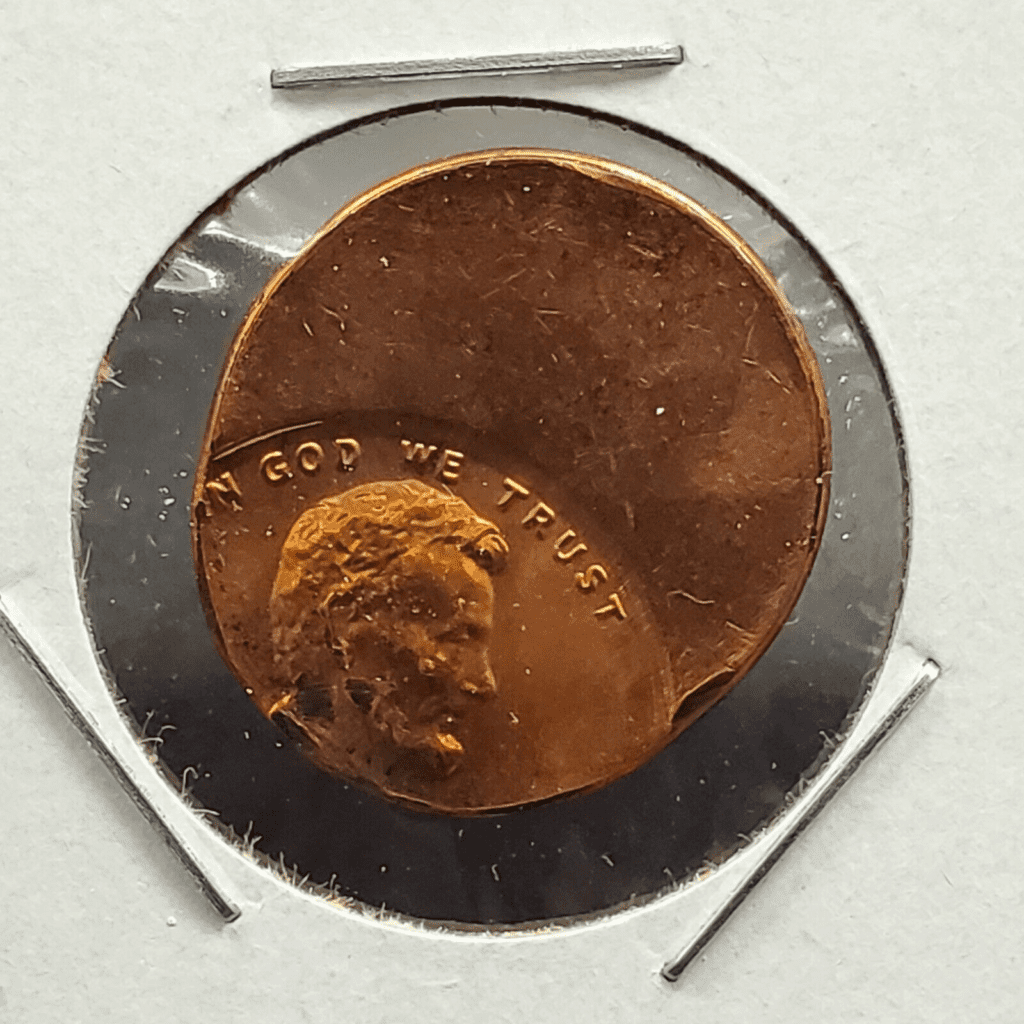
Now, other errors can happen. For example, planchets may not be made in a perfect circle during the cutting of planchets. There could be a clipped or folded area. Strikes can become weak, or strikes can be done twice, which leads to double die reverse (DDR) or double die obverse (DDO).
How Much Is the 1959 Lincoln Penny Worth Today?
The 1959 Lincoln penny is worth 1 cent, as its face value suggests. The melt value is a little higher, which is $0.0254.
Nevertheless, you’ll be pleasantly surprised that 1959 Lincoln pennies are extremely valuable.
Here’s a 1959 Lincoln Penny values chart that will help you get an overview of the 1959 penny pricing:
| Coin | Condition | Grade | Mintage | Value |
| 1959 D Lincoln penny | Circulated/mint | Not graded | 1,279,760,000 | $0.01 to $15.00 |
| 1959 D Lincoln penny | Uncirculated/mint | MS-65 | 1,279,760,000 | $3 to $20 |
| 1959 D Lincoln penny | Uncirculated/mint | MS-66 | 1,279,760,000 | $9 to $89 |
| 1959 D Lincoln penny | Uncirculated/mint | MS-67 | 1,279,760,000 | $75 to $204 |
| 1959 P Lincoln penny | Circulated/mint | Not graded | 609,715,000 | $0.01 to $14.00
|
| 1959 P Lincoln penny | Uncirculated/mint | MS-65 | 609,715,000 | $6 to $1,116 |
| 1959 P Lincoln penny | Uncirculated/mint | MS-66 | 609,715,000 | $25 to $40 |
| 1959 P Lincoln penny | Uncirculated/mint | MS-67 | 609,715,000 | $216 to $528 |
| 1959 Proof Lincoln penny | Circulated/proof | Not graded | 1,149,291 | $0.01 to $31.00 |
| 1959 Proof Lincoln penny | Uncirculated/proof | PR-67 | 1,149,291 | $21 to $86 |
| 1959 Proof Lincoln penny | Uncirculated/proof | PR-68 | 1,149,291 | $69 to $168 |
| 1959 Proof Lincoln penny | Uncirculated/proof | PR-69 | 1,149,291 | $336 to $2,400 |
As you can see, the 1959 penny is truly valuable only if you have a coin with a high grade. To give you an idea, the auction record for the 1959-proof penny coin is $20,700. This coin has a grade of PR69 and was sold in January 2004 by Heritage Auctions.
For the 1959 D penny, the auction record is $6,999 for a penny with an MS68RD grade. For the 1959 P penny, the auction record is $5,887.
How Does The Grading System Work?
The Sheldon Scale is used by numismatists to provide a numerical value to coins. The Sheldon Scale goes from poor (P-1) to perfect mint state (P-1) (MS-70). Coins were originally evaluated using words to reflect their condition (Good, Fair, Excellent, Etc.). Unfortunately, coin collectors and dealers had different ideas about what each of these terms represent.
Professional numismatists joined together in the 1970s and established CoinGrading standards. These numismatists now assign grades at key places on the seventy-point scale, using the most regularly utilized numeric points in conjunction with the original adjective grade. The following are the most common coin grades:
-
-
- (P-1) Poor – Indistinguishable and probably damaged; if used, must have a date and mintmark; otherwise, rather battered.
- (FR-2) Fair – Nearly smooth, but without the damage that a coin graded Poor often possesses. The coin must have enough detail to be identified.
- (G-4) Fair – Inscriptions have merged into the rims in some areas, and important elements have been mostly erased.
- (VG-8) Very Good- A little weathered, but all of the primary design elements are visible, albeit faintly. There is little if any, central detail left.
- (F-12) Good – The item is very worn, yet the wear is even, and the overall design details stand out clearly. Rims are almost completely isolated from the field.
- (VF-20) Very Fine – Moderately weathered, with some finer features still visible. The motto or all letters of LIBERTY are readable. Both sides of the coin have entire rims that are separated from the field.
- (EF-40) Extremely Fine – Gently used; all gadgets are visible, and the most important ones are bold. The finer details are bold and clear, however, light wear may be seen.
- (AU-50) Uncirculated – Slight evidence of wear on the coin’s design’s high points; may have contact marks; eye appeal should be adequate.
- (AU-58) Uncirculated Choice – Slight traces of wear, no severe contact marks, almost full mint shine, and great eye appeal.
- (MS-60) Mint State Basal – Strictly uncirculated; no indication of wear on the coin’s highest points, but an unsightly coin with reduced luster, visible contact marks, hairlines, and other flaws.
- (MS-63) Mint State Acceptable – Uncirculated, but with contact scratches and nicks, little reduced shine, but otherwise appealing appearance. The strike is weak to average.
- (MS-65) Mint State Choice – Uncirculated with great mint shine, very little contact blemishes, and exceptional eye appeal. The strike is unusually severe.
- (MS-68) Mint State Premium Quality – Uncirculated with superb luster, no obvious contact marks to the naked eye, and exceptional eye appeal. The strike is quick and appealing.
- (MS-69) Almost Perfect Mint State – Uncirculated with perfect brilliance, a sharp and appealing strike, and extremely good eye appeal. A near-perfect coin with minor imperfections in the planchet, strike, and contact markings (seen only under 8x magnification).
- (MS-70) Mint State Perfect – Under 8x magnification, there are no tiny imperfections discernible; the strike is crisp, and the coin is perfectly centered on a beautiful planchet. Rarely seen on a coin, this coin is bright and whole, with original luster and exceptional eye appeal.
-
Are There Any Rare 1959 Lincoln Penny?
There are rare 1959 Lincoln pennies and most of them are rare by condition. This means that 1959 coins are rare because of their superb attractiveness, color, and strike.
For example, 1959 pennies with grades of at least MS67 and PR68 are considered rare because only a few of these coins exist today. Consider the 1959 D Lincoln penny with MS67 grade. They are rare because only about 50 pieces of them are known to survive.
There are also times when a 1959 Lincoln penny becomes rare because of the error that it has. For rare 1959 coins, prices can easily reach thousands of dollars.
Where To Buy Or Sell 1959 Lincoln Penny?
You can buy or sell 1959 Lincoln pennies both online and offline. Some of the best places to buy or sell 1959 Lincoln pennies are eBay, Amazon, Etsy, USA Coin Book, Coin Tracker, Grey Sheet, and other specialized websites.
Offline, you can go to coin shops, antique stores, pawnshops, and collectors. You can also join auctions where some of the best 1959 pennies are on sale.
FAQs
Is there a 1959 penny worth $3000?
There are 1959 pennies worth $3,000 or even more than that. 1959 pennies with a grade of at least MS 66 or PR67 could be as valuable as $3,000.
What is a 1959-D mule penny?
The 1959-D mule penny is among the most controversial coins in US history. 1959 was the first time the penny received a Lincoln Memorial reverse. However, the 1959-D mule penny has the wheat design on its reverse side.
In 1986, Leon Baller claimed that he had a 1959-D mule penny. It was initially examined and considered genuine by the United States Department of Treasury. However, professional grading service providers repeatedly considered it fake.
To make things even more controversial, Mark Hoffman claimed that he made the coin through the spark erosion process, and thus, it was fake. The Secret Service, however, refuted that claim.
Baller sold the coin to Heritage Auctions. Later, the coin appeared in a Goldberg’s Auction, where it was sold for $48,300. In 2010, the coin was resold for $31,050.
How do you tell if a coin is a mule?
A coin is a mule when it has reverse and obverse designs that are not normally seen on the same coin. So, for example, when you have a penny obverse but a dime reverse. A coin can also be a mule when it has a business strike on the head but a proof strike on the tail.

